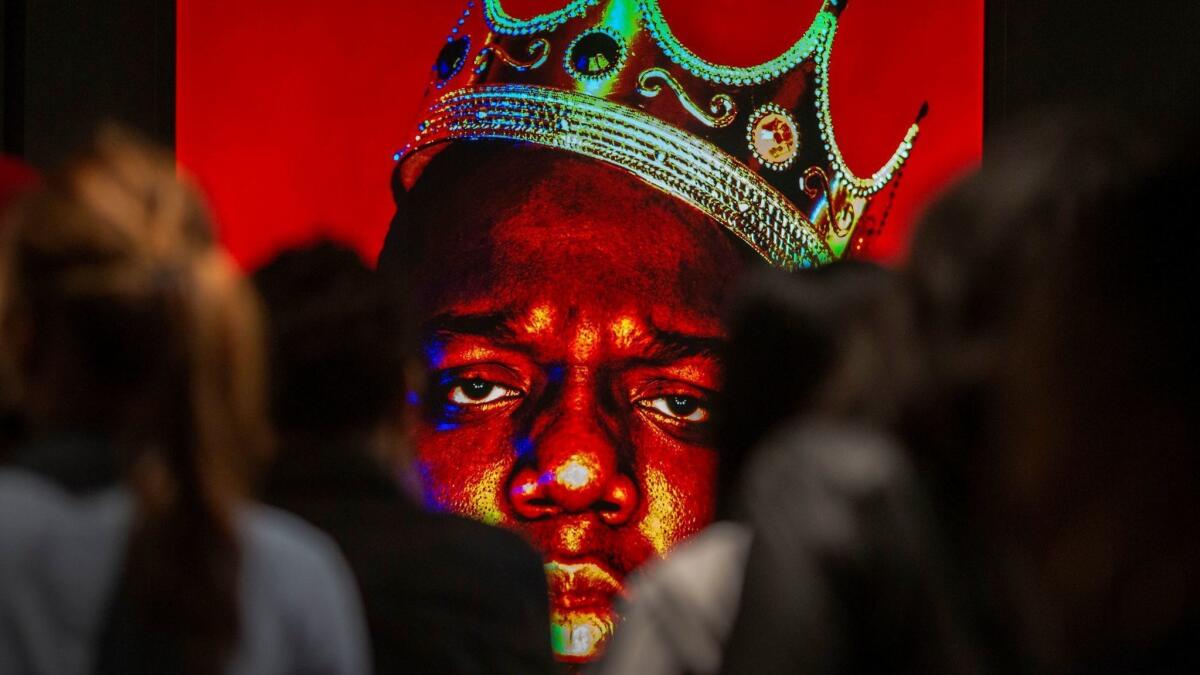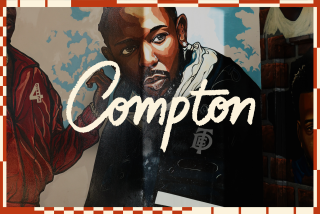A panoramic history of hip-hop, from the Bronx to Compton
- Share via
Alonzo “Lonzo” Williams has strong opinions about the birth of West Coast hip-hop, back when he was a young DJ and club owner in Compton, crossing paths with Dr. Dre, Eazy-E and other future members of a soon-to-be notorious group called N.W.A.
“We all were key players in the early stages of West Coast hip-hop. I probably was the most keyest of all,” Williams says with a chuckle, not exactly making a joke.
As owner of the club Eve’s After Dark in the 1980s, Williams was a neighborhood impresario, with a recording studio on the premises and his own electro-R&B-hip-hop group called the World Class Wreckin’ Cru. (Dre was a member.) Williams was even depicted briefly in the acclaimed 2015 N.W.A biopic “Straight Outta Compton,” of which he says, “My life has not been the same since.”
The rise of the West Coast is just one slice of the exhibition “Contact High: A Visual History of Hip-Hop,” now at the Annenberg Space for Photography through Aug. 18. Curated by Vikki Tobak and inspired by her 2018 book of the same name, it is the most comprehensive survey of pictures documenting hip-hop culture ever collected, stretching from the pioneering Bronx DJ Kool Herc to Compton’s Pulitzer-wining Kendrick Lamar.
Not surprisingly, Williams would have loved even more representation of West Coast rap music in the show, which already includes striking images of Snoop Dogg, DJ Quik, Nipsey Hussle and Tupac Shakur. But Williams will make his case at the Annenberg during a July 20 panel discussion, “California Love: A Hip-Hop History,” joined by radio DJ Greg Mack and music journalist Sheena Lester.
“We had a consistent flow of West Coast superstars that influenced the younger generations,” says Williams. “Everybody has a sense of pride when it comes to our musical legacy.”
The panel is one of several special events, screenings, live podcasts and field trips scheduled in the exhibition. On June 1, photographer Barron Claiborne will be at the Annenberg to re-create his iconic image of a crown-wearing Biggie Smalls, inviting visitors to step into the frame and wear the rapper’s original royal headgear.

In its earliest form, hip-hop was almost exclusively a street-level mode of expression, embraced quickly by other underground scenes, while the mainstream kept the sound and culture at arm’s length.
“I always like to describe it as adolescent teenage activity going on in the streets to amuse ourselves — the graffiti, the whole thing,” says Fab 5 Freddy, creative director on “Contact High” and a charter participant in the interconnecting worlds of rap and graffiti art in the late 1970s. He’s now an artist and filmmaker.
Joe Conzo Jr., whose work is featured in the exhibition, started taking photos of the hip-hop scene while he was a junior at South Bronx High School, with his friends the Cold Crush Brothers and Kool Herc. Conzo was among the very first to shoot that scene in the late ’70s with a good 35mm camera rather than a Kodak Instamatic.
Another featured photographer, Janette Beckman, took photos for the influential U.K. music magazine Melody Maker. Beckman discovered hip-hop in 1982 when the first tour of American rappers, DJs, graffiti artists and break dancers arrived in Europe. Led by Afrika Bambaataa, the tour, says curator Tobak, was “the first time people in Europe got a full dose of the culture.”
Beckman recalls that other music journalists and photographers at the time were not interested. “The main journalists wrote, ‘Oh, this rap thing is never going to last,’ ” Beckman says with a laugh. “I was just like, ‘These people are amazing.’ ”
After years of shooting the early years of punk rock, she recognized hip-hop as another revolutionary cultural movement and moved to New York to explore it further.
“Most press thought it was a passing fad,” says Fab 5 Freddy. “They didn’t understand the cultural significance and relevance. Joe Conzo and Janette Beckman felt it and pointed their cameras.”
On the West Coast, photographer Mike Miller was a fifth-generation L.A. native whose repertoire ranged from Stan Getz and latter-day Lynyrd Skynyrd to the first generation of L.A.’s gangsta rappers. His pictures from that era, some of which are seen in the Annenberg show, included portraits of former N.W.A members Arabian Prince and Ice Cube, and a scene-setting album cover for Warren G’s 1994 multi-platinum debut, “Regulate... G Funk Era.”
“To bring the artists down to the neighborhoods that they grew up in was a no-brainer for me,” says Miller, who photographed Warren G and others close to home. “The way I approached the photographs gave it a real feel. It looked journalistic.”
As usual at the Annenberg, the exhibition is accompanied by a new documentary, including footage of legendary Life magazine photographer Gordon Parks shooting a panoramic group photo in New York of a 1998 summit of rappers and DJs from across the country. “Contact High” has an onsite record shop where visitors can purchase the same vinyl that was sampled to create some of the great works of hip-hop, and on the wall is a new hand-painted graffiti mural created by Cey Adams, the first creative director at Def Jam Records.
The exhibit’s pictures document an ongoing movement of diverse artists right up to the present decade, among them ASAP Rocky, XXXTentacion — in his only formal portrait session before he was killed last year — and Nicki Minaj.
“It continues to be a platform for young people around the world to figure out ways of expressing themselves,” says Fab 5 Freddy. “Seeing Travis Scott at Coachella two years ago, I wasn’t prepared for the intensity. Oh my God, I know what this is! I saw that stuff in the beginning.”
“Contact High: A Visual History of Hip-Hop”
Where: Annenberg Space for Photography, 2000 Avenue of the Stars, Los Angeles
When: Through Aug. 18
Info: AnnenbergPhotoSpace.org
More to Read
The biggest entertainment stories
Get our big stories about Hollywood, film, television, music, arts, culture and more right in your inbox as soon as they publish.
You may occasionally receive promotional content from the Los Angeles Times.











